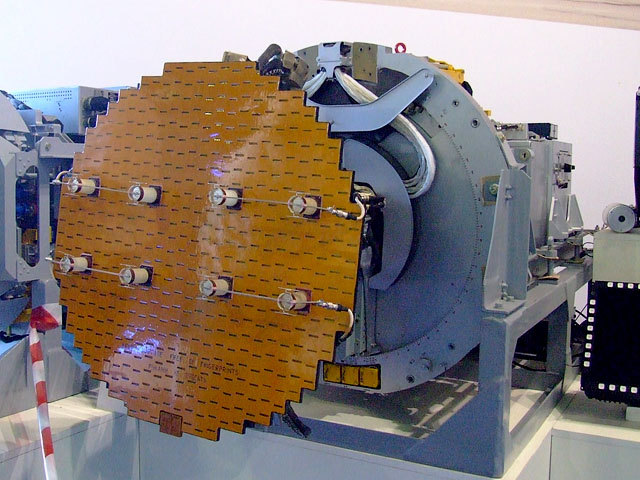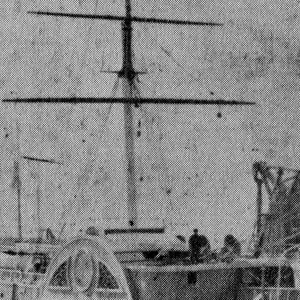|
Ambiguity Resolution
Ambiguity resolution is used to find the value of a measurement that requires modulo sampling. This is required for pulse-Doppler radar signal processing. Measurements Some types of measurements introduce an unavoidable modulo operation in the measurement process. This happens with all radar systems. Radar aliasing happens when: * Pulse repetition frequency (PRF) is too low to sample Doppler frequency directly * PRF is too high to sample range directly Pulse Doppler sonar uses similar principles to measure position and velocity involving liquids. Radar Systems Radar systems operating at a PRF below about 3 kHz pulse rate produce true range, but produce ambiguous target speed. Radar systems operating at a PRF above 30 kHz produce true target speed, but produce ambiguous target range. Medium PRF systems produce both ambiguous range measurement and ambiguous radial speed measurement using PRF from 3 kHz to 30 kHz. Ambiguity resolution finds true range and tr ... [...More Info...] [...Related Items...] OR: [Wikipedia] [Google] [Baidu] |
Modulo Operation
In computing, the modulo operation returns the remainder or signed remainder of a division, after one number is divided by another (called the '' modulus'' of the operation). Given two positive numbers and , modulo (often abbreviated as ) is the remainder of the Euclidean division of by , where is the dividend and is the divisor. For example, the expression "5 mod 2" would evaluate to 1, because 5 divided by 2 has a quotient of 2 and a remainder of 1, while "9 mod 3" would evaluate to 0, because 9 divided by 3 has a quotient of 3 and a remainder of 0; there is nothing to subtract from 9 after multiplying 3 times 3. Although typically performed with and both being integers, many computing systems now allow other types of numeric operands. The range of values for an integer modulo operation of is 0 to inclusive ( mod 1 is always 0; is undefined, possibly resulting in a division by zero error in some programming languages). See Modular arithmetic for an older and re ... [...More Info...] [...Related Items...] OR: [Wikipedia] [Google] [Baidu] |
Pulse-Doppler Radar
A pulse-Doppler radar is a radar system that determines the range to a target using pulse-timing techniques, and uses the Doppler effect of the returned signal to determine the target object's velocity. It combines the features of pulse radars and continuous-wave radars, which were formerly separate due to the complexity of the electronics. The first operational Pulse Doppler radar was in the CIM-10 Bomarc, an American long range supersonic missile powered by ramjet engines, and which was armed with a W40 nuclear weapon to destroy entire formations of attacking enemy aircraft. Pulse-Doppler systems were first widely used on fighter aircraft starting in the 1960s. Earlier radars had used pulse-timing in order to determine range and the angle of the antenna (or similar means) to determine the bearing. However, this only worked when the radar antenna was not pointed down; in that case the reflection off the ground overwhelmed any returns from other objects. As the ground moves at ... [...More Info...] [...Related Items...] OR: [Wikipedia] [Google] [Baidu] |
Radar
Radar is a detection system that uses radio waves to determine the distance ('' ranging''), angle, and radial velocity of objects relative to the site. It can be used to detect aircraft, ships, spacecraft, guided missiles, motor vehicles, weather formations, and terrain. A radar system consists of a transmitter producing electromagnetic waves in the radio or microwaves domain, a transmitting antenna, a receiving antenna (often the same antenna is used for transmitting and receiving) and a receiver and processor to determine properties of the objects. Radio waves (pulsed or continuous) from the transmitter reflect off the objects and return to the receiver, giving information about the objects' locations and speeds. Radar was developed secretly for military use by several countries in the period before and during World War II. A key development was the cavity magnetron in the United Kingdom, which allowed the creation of relatively small systems with sub-meter resolution ... [...More Info...] [...Related Items...] OR: [Wikipedia] [Google] [Baidu] |
Aliasing
In signal processing and related disciplines, aliasing is an effect that causes different signals to become indistinguishable (or ''aliases'' of one another) when sampled. It also often refers to the distortion or artifact that results when a signal reconstructed from samples is different from the original continuous signal. Aliasing can occur in signals sampled in time, for instance digital audio, or the stroboscopic effect, and is referred to as temporal aliasing. It can also occur in spatially sampled signals (e.g. moiré patterns in digital images); this type of aliasing is called spatial aliasing. Aliasing is generally avoided by applying low-pass filters or anti-aliasing filters (AAF) to the input signal before sampling and when converting a signal from a higher to a lower sampling rate. Suitable reconstruction filtering should then be used when restoring the sampled signal to the continuous domain or converting a signal from a lower to a higher sampling rate. F ... [...More Info...] [...Related Items...] OR: [Wikipedia] [Google] [Baidu] |
Pulse Repetition Frequency
The pulse repetition frequency (PRF) is the number of pulses of a repeating signal in a specific time unit. The term is used within a number of technical disciplines, notably radar. In radar, a radio signal of a particular carrier frequency is turned on and off; the term "frequency" refers to the carrier, while the PRF refers to the number of switches. Both are measured in terms of cycle per second, or hertz. The PRF is normally much lower than the frequency. For instance, a typical World War II radar like the Type 7 GCI radar had a basic carrier frequency of 209 MHz (209 million cycles per second) and a PRF of 300 or 500 pulses per second. A related measure is the pulse width, the amount of time the transmitter is turned on during each pulse. After producing a brief pulse of radio signal, the transmitter is turned off in order for the receiver units to hear the reflections of that signal off distant targets. Since the radio signal has to travel out to the target and back ag ... [...More Info...] [...Related Items...] OR: [Wikipedia] [Google] [Baidu] |
Pulse-doppler Ambiguity Zones
A pulse-Doppler radar is a radar system that determines the range to a target using pulse-timing techniques, and uses the Doppler effect of the returned signal to determine the target object's velocity. It combines the features of pulse radars and continuous-wave radars, which were formerly separate due to the complexity of the electronics. The first operational Pulse Doppler radar was in the CIM-10 Bomarc, an American long range supersonic missile powered by ramjet engines, and which was armed with a W40 nuclear weapon to destroy entire formations of attacking enemy aircraft. Pulse-Doppler systems were first widely used on fighter aircraft starting in the 1960s. Earlier radars had used pulse-timing in order to determine range and the angle of the antenna (or similar means) to determine the bearing. However, this only worked when the radar antenna was not pointed down; in that case the reflection off the ground overwhelmed any returns from other objects. As the ground moves at ... [...More Info...] [...Related Items...] OR: [Wikipedia] [Google] [Baidu] |
Range Ambiguity Resolution
Range ambiguity resolution is a technique used with medium Pulse repetition frequency (PRF) radar to obtain range information for distances that exceed the distance between transmit pulses. This signal processing technique is required with pulse-Doppler radar. The raw return signal from a reflection will appear to be arriving from a distance less than the true range of the reflection when the wavelength of the pulse repetition frequency (PRF) is less than the range of the reflection. This causes reflected signals to be folded, so that the apparent range is a modulo function of true range. Definition Range aliasing occurs when reflections arrive from distances that exceed the distance between transmit pulses at a specific pulse repetition frequency (PRF). Range ambiguity resolution is required to obtain the true range when the measurements are made using a system where the following inequality is true. :\text > \left (\frac \right) Here ''c'' is the signal speed, which fo ... [...More Info...] [...Related Items...] OR: [Wikipedia] [Google] [Baidu] |
Fast Fourier Transform
A fast Fourier transform (FFT) is an algorithm that computes the discrete Fourier transform (DFT) of a sequence, or its inverse (IDFT). Fourier analysis converts a signal from its original domain (often time or space) to a representation in the frequency domain and vice versa. The DFT is obtained by decomposing a sequence of values into components of different frequencies. This operation is useful in many fields, but computing it directly from the definition is often too slow to be practical. An FFT rapidly computes such transformations by factorizing the DFT matrix into a product of sparse (mostly zero) factors. As a result, it manages to reduce the complexity of computing the DFT from O\left(N^2\right), which arises if one simply applies the definition of DFT, to O(N \log N), where N is the data size. The difference in speed can be enormous, especially for long data sets where ''N'' may be in the thousands or millions. In the presence of round-off error, many FFT algorith ... [...More Info...] [...Related Items...] OR: [Wikipedia] [Google] [Baidu] |
Discrete Fourier Transform
In mathematics, the discrete Fourier transform (DFT) converts a finite sequence of equally-spaced Sampling (signal processing), samples of a function (mathematics), function into a same-length sequence of equally-spaced samples of the discrete-time Fourier transform (DTFT), which is a complex number, complex-valued function of frequency. The interval at which the DTFT is sampled is the reciprocal of the duration of the input sequence. An inverse DFT is a Fourier series, using the DTFT samples as coefficients of complex number, complex Sine wave, sinusoids at the corresponding DTFT frequencies. It has the same sample-values as the original input sequence. The DFT is therefore said to be a frequency domain representation of the original input sequence. If the original sequence spans all the non-zero values of a function, its DTFT is continuous (and periodic), and the DFT provides discrete samples of one cycle. If the original sequence is one cycle of a periodic function, th ... [...More Info...] [...Related Items...] OR: [Wikipedia] [Google] [Baidu] |
Frequency Ambiguity Resolution
Frequency ambiguity resolution is used to find the true target velocity for medium pulse repetition frequency (PRF) radar systems. This is used with pulse-Doppler radar. Definition Radial velocity aliasing occurs when reflections arrive from reflectors moving fast enough for the Doppler frequency to exceed the pulse repetition frequency (PRF). Frequency ambiguity resolution is required to obtain the true radial velocity when the measurements is made using a system where the following inequality is true. :Radial \ Velocity > 0.5 \left (\frac \right) The radial velocity measurements made in this way produce a modulo function of the true radial velocity. :Apparent \ Velocity = (True Velocity) MOD \left (\frac \right) Theory Radar pulsing causes a phenomenon called aliasing, which occurs when the Doppler frequency created by reflector motion exceeds the pulse repetition frequency (PRF). This concept is related to range ambiguity resolution. Doppler frequency shift is intr ... [...More Info...] [...Related Items...] OR: [Wikipedia] [Google] [Baidu] |
Radar
Radar is a detection system that uses radio waves to determine the distance ('' ranging''), angle, and radial velocity of objects relative to the site. It can be used to detect aircraft, ships, spacecraft, guided missiles, motor vehicles, weather formations, and terrain. A radar system consists of a transmitter producing electromagnetic waves in the radio or microwaves domain, a transmitting antenna, a receiving antenna (often the same antenna is used for transmitting and receiving) and a receiver and processor to determine properties of the objects. Radio waves (pulsed or continuous) from the transmitter reflect off the objects and return to the receiver, giving information about the objects' locations and speeds. Radar was developed secretly for military use by several countries in the period before and during World War II. A key development was the cavity magnetron in the United Kingdom, which allowed the creation of relatively small systems with sub-meter resolution ... [...More Info...] [...Related Items...] OR: [Wikipedia] [Google] [Baidu] |
Doppler Effects
The Doppler effect or Doppler shift (or simply Doppler, when in context) is the change in frequency of a wave in relation to an observer who is moving relative to the wave source. It is named after the Austrian physicist Christian Doppler, who described the phenomenon in 1842. A common example of Doppler shift is the change of pitch heard when a vehicle sounding a horn approaches and recedes from an observer. Compared to the emitted frequency, the received frequency is higher during the approach, identical at the instant of passing by, and lower during the recession. The reason for the Doppler effect is that when the source of the waves is moving towards the observer, each successive wave crest is emitted from a position closer to the observer than the crest of the previous wave. Therefore, each wave takes slightly less time to reach the observer than the previous wave. Hence, the time between the arrivals of successive wave crests at the observer is reduced, causing an incr ... [...More Info...] [...Related Items...] OR: [Wikipedia] [Google] [Baidu] |






